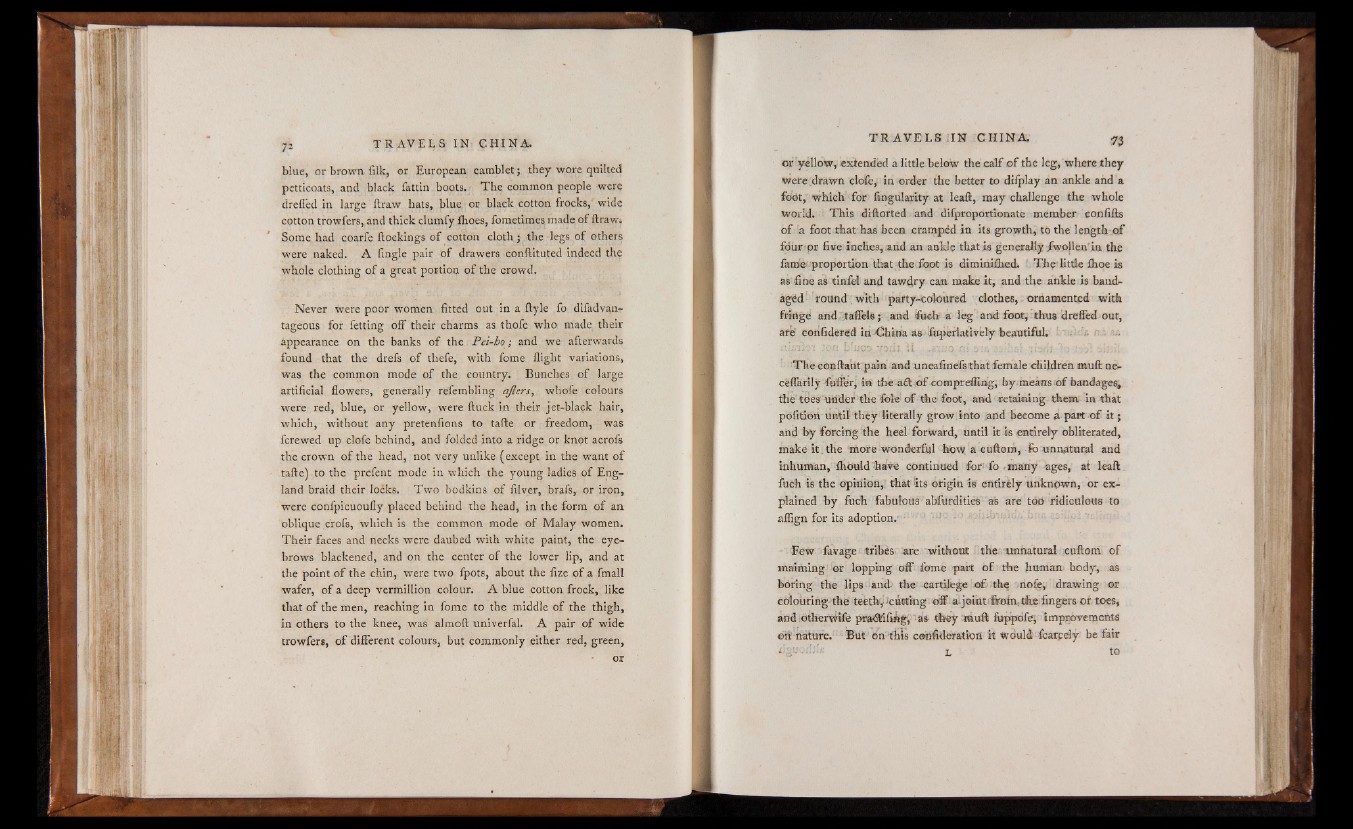
blue, or brown filk, or European camblet; they wore quilted
petticoats, and black fattin boots. The common people were
drefled in large ftraw hats, blue or black cotton frocks, wide
cotton trowfers, ánd thick clumfy Ihoes, fometimesmade o f ftraw.
Some had coarfe ftockings o f cotton cloth; the legs o f others
were naked. A fingle pair o f drawers conflituted indeed the
whole clothing o f a great portion o f the crowd.
Never were poor women fitted out in a ftyle fo difadvan-
tageous for fetting off their charms as thofe who made their
appearance on the banks o f the P ei-ho; and we afterwards
found that the drefs o f thefe, with fome flight variations,
was the common mode o f the country. Bunches o f large
artificial flowers, generally refembling aflsrs, whofe colours
were red, blue, or yellow, were ftuck in their jet-black hair,
which, without any pretenfions to tafte or freedom, was
fcrewed up clofe behind, and folded into a ridge or knot acrofs
the crown o f the head, not very unlike (except in the want o f
tafte) to the prefent mode in which the young ladies o f England
braid their locks. Tw o bodkins o f filver, brafs, or iron,
were confpicuoufly placed behind the head, in the form o f an
oblique crofs, which is the common mode o f Malay women.
Their faces and necks were daubed with white paint, the eyebrows
blackened, and on the center o f the lower lip, and at
the point o f the chin, were two fpots, about the fize o f a fmall
wafer, o f a deep vermillion colour. A blue cotton frock, like
that o f the men, reaching in fome to the middle o f the thigh,
in others to the knee, was almoft univerfal. A pair o f wide
trowfers, o f different colours, but commonly either red, green,
or
or yellow, extended a little below the calf o f the leg, where ¡they
were .drawn clofe, in order the better to difplay an ankle and a
foot, which for Angularity at leaft, may challenge the whole
world. This diftorted and difproportionate member eonfifts
o f la foot that has been cramped in its growth, to the length o f
fdur or fiwe inches, and an ankle that is generally/wollen'ia the
fame proportion that the foot is diminiihed. 1 T h e little fhoe is
as fine as tinfel and tawdry can make it, and the ankle is bandaged
round. with party-coloured clothes, ornamented with
fringe and taffels; and fiich a leg and foot, thus dreffed out,
are confidered in'China as fuperiatively beautiful. - ••
T he conftarit pain and uneafinefsthat female children muft ne-
ceffarily fuffer, lit tfae-a£Tof compreffirig, by means o f bandages,
the toes un defthe fo k of-'the-foot,' and retaining them in that
pofition until they literally grow into and become a part o f i t ;
and by forcing the heel forward, until it is entirely obliterated,
make it . the more wonderful how a euftom, lb unnatural and
inhuman, fhouldhave continued for-' fo . many ages, at leaft
fuch is the opinion, that its origin is entirely unknown, or explained
b y fuch fabulous abfurdities as are tori ridiculous to
aflign for its adoption.-
Few favage tribes- are without the unnatural euftom o f
maiming or lopping off fame part o f the human body, as
boring the lips and the cartilege o f the -nolle, drawing or
colouring the teethy 'cutting <M a-joint froln.the fingers or toes,
and otlierwife pradfiiingj as they -muft fu-ppofe; improvements
oft nature. But on'this cohfideratkm it would fcarpely be fair
dgnoibk L to